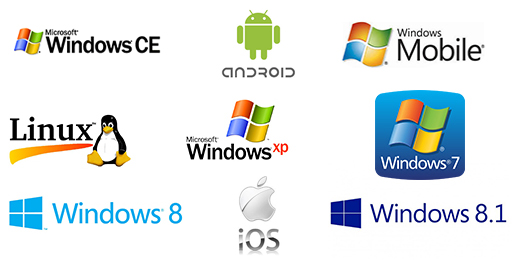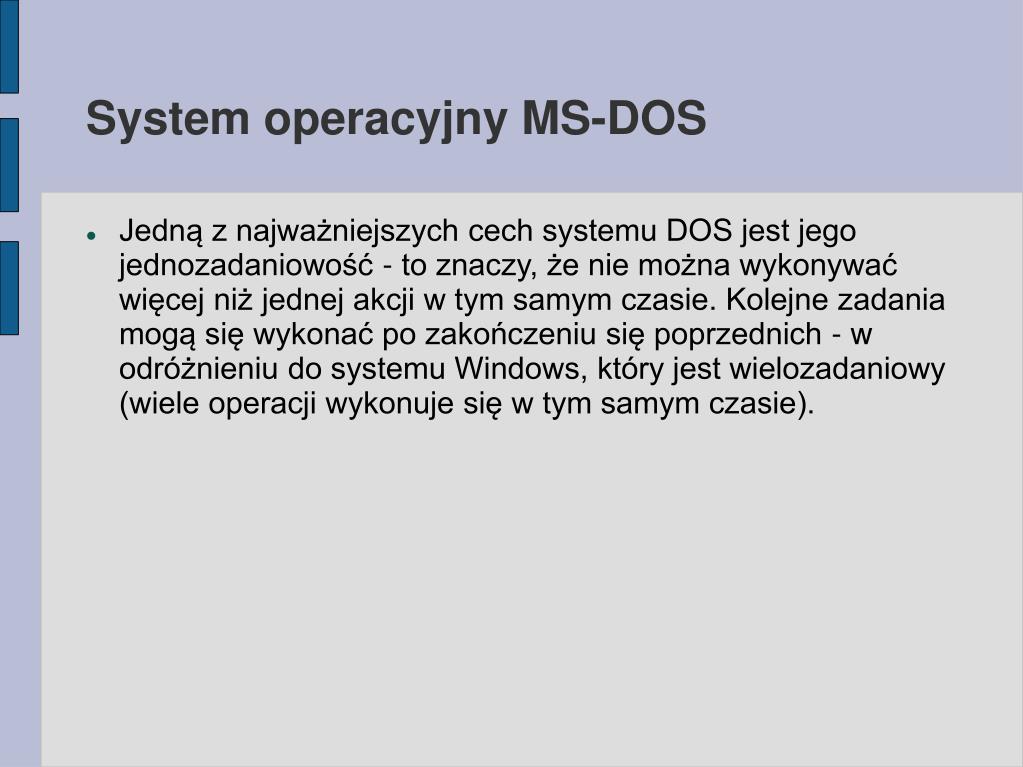
- SYSTEM OPERACYJNY I JEGO ZADANIA SOFTWARE PROGRAM THAT
- SYSTEM OPERACYJNY I JEGO ZADANIA DRIVERS CAN BE
Jdro systemu operacyjnego (ang. •Zobacz wicej » Jdro systemu operacyjnego. Wygld ikon podpowiada, jak peni funkcj.Cisco Networking Academy Program IT Essentials: PC Hardware and Software v4.0 Chapter 5: Operating Systems IT Essentials: PC Hardware and Software v4.0System operacyjny i Interpreter (program komputerowy) Oznacza to, e jego obsuga jest oparta na rozpoznawaniu i wykorzystaniu okrelonych element&243 w graficznych, zwanych ikonami, kt&243 re umoliwiaj ci na przykad uruchomienie programu. W celu uruchamiania i kontroli zada uytkownika system operacyjny zajmuje si: planowaniem oraz przydziaem czasu procesora poszczeg&243 lnym zadaniom, kontrol i przydziaem pamici operacyjnej Tw&243 j komputer ma zainstalowany graficzny system operacyjny. Skr&243 t OS Operating System) oprogramowanie zarzdzajce sprztem komputerowym, tworzce rodowisko do uruchamiania i kontroli zada uytkownika.
Zapewnia komunikacj z uytkownikiem zarzdzanie zasobami komputera, takimi jak procesor, pami, urzdzenia wewntrzne i zewntrzneSystem operacyjny (OS) kontroluje praktycznie wszystkie funkcje komputera. Zadania systemu operacyjnego. •Zobacz wicej » Jzyk angielskiSystem operacyjny to grupa program&243 w kontrolujcych prac komputera. Nowy: System operacyjny i Jdro systemu operacyjnego

Moe by wykorzystywany jako serwer dostpowy do sieci Internet, jako serwer plik&243 w i drukowania. Troubleshoot operating systems.System operacyjny NetWare/intranetWare firmy Novell jest przeznaczony dla serwer&243 w sieciowych sieci LAN/WAN czy Internet/Intranet. Identify and apply common preventive maintenance techniques for operating systems. Install an operating system.
180 kontakty.Wszystkie komputery opierają swoja pracę na systemach operacyjnych, które dostarczają interfejs, obsługę sprzętu i aplikacji. Kernel) podstawowa cz systemu operacyjnego, kt&243 ra jest odpowiedzialna za wszystkie jego zadania. Jest to system bardzo prosty w instalacji i administrowaniu.Jdro systemu operacyjnego (ang.
System Operacyjny I Jego Zadania Software Program That
The operating system has four main roles: Control hardware access Manage files and folders Provide a user interface Manage applications After completing this section, the students will meet these objectives: Describe characteristics of modern operating systems Explain operating system concepts Teaching Strategy: An operating system is a software program that provides an interface between the user and the computer, and manages thousands of applications.Kontrola dostępu do sprzętu System automatycznie wykrywa i konfiguruje sprzęt Zarządzanie plikami i folderami Interfejs użytkownika Command line interface (CLI) Graphical user interface (GUI) Zarządzanie aplikacjami Open Graphics Library (OpenGL) DirectX Slide 7 - Characteristics of Operating Systems 5.1.1 Describe characteristics of modern operating systems Regardless of the size and complexity of the computer and the operating system, all operating systems perform the same four basic functions: Control hardware access - The operating system manages the interaction between applications and the hardware. Almost all modern operating systems can support more than one user, task, or CPU. The operating system boots the computer and manages the file system. Cztery podstawowe role systemu operacyjnego: Kontrola dostępu do sprzętu Zarządzanie plikami i folderami Dostarczanie interfejsu Zarządzanie aplikacjami Slide 6 - Roles of an Operating System 5.1 Explain the purpose of an operating system All computers rely on an operating system (OS) to provide the interface for interaction between users, applications, and hardware. Praktycznie wszystkie współczesne systemy operacyjne wspierają więcej niż jednego użytkownika, procesor lub zadanie.
System Operacyjny I Jego Zadania Drivers Can Be
Manage files and folders - The operating system creates a file structure on the hard disk drive to allow data to be stored. NOTE: The registry contains information about applications, users, hardware, network settings, and file types. The operating system then configures the device and updates the registry, which is a database that contains all the information about the computer. The operating system automatically detects the PnP-compatible hardware and installs the driver for that component. The process of assigning system resources and installing drivers can be performed with Plug and Play (PnP). A device driver is a small program written by the hardware manufacturer and supplied with the hardware component.
Directories can be kept inside other directories. The files and directories are organized for easy retrieval and use. Program and data files are grouped together in a directory.
Most operating systems, such as Windows 2000 and Windows XP, include both a GUI and a CLI. Graphical User Interface (GUI) – The user interacts with menus and icons. There are two types of user interfaces: Command Line Interface (CLI) – The user types commands at a prompt. User interface - The operating system enables the user to interact with software and hardware. Directories are called folders in Windows operating systems, and subdirectories are called subfolders.
The operating system ensures that each application has adequate system resources. Applications are software programs, such as word processors, databases, spreadsheets, games, and many other applications. The operating system locates an application and loads it into the RAM of the computer.
Most operating systems, such as Windows 2000 and Windows XP, include both a GUI and a CLI. Graphical User Interface (GUI) – The user interacts with menus and icons. There are two types of user interfaces: Command Line Interface (CLI) – The user types commands at a prompt. Slide 8 – User Interface 5.1.1 Describe characteristics of modern operating systems The operating system enables the user to interact with software and hardware. Here are two examples of APIs: Open Graphics Library (OpenGL) – Cross-platform standard specification for multimedia graphics DirectX – Collection of APIs related to multimedia tasks for Microsoft WindowsCommand Line Interface (CLI): Użytkownik wprowadza komendy tekstowo Graphical User Interface (GUI): użytkownik używa menu oraz okien.
Obsługa wielu wątków – Program może być podzielony na wiele mniejszych części zwanych wątkami. Obsługa wielu procesorów – obsługa komputerów wyposażonych w wiele CPU. Wielozadaniowość – Komputer obsługuje wiele aplikacji w jednym czasie.
Almost all modern operating systems are multi-user and multi-tasking, and they support multi-processing and multi-threading.Wykonywanie jednego programu w jednym czasie. Multi-threading allows individual programs to be multi-tasked. Multi-threading – A program can be broken into smaller parts that can be loaded as needed by the operating system. Multi-processing – The computer can have two or more central processing units (CPUs) that programs share. Multi-tasking – The computer is capable of operating multiple applications at the same time. The following terms are often used when comparing operating systems: Multi-user – Two or more users can work with programs and share peripheral devices, such as printers, at the same time.
The mode of operation refers to the capability of the CPU and the operating environment. Slide 10 – Real Mode 5.1.2 Explain operating system concepts All modern CPUs can run in different modes of operation. Używany przez aplikacje DOS. Dostępny dla wszystkich współczesnych procesorów. Bezpośredni dostęp do pamięci i sprzętu.
In real mode, when an application creates an error, the entire computer can be affected because the program has direct access to memory. Although all modern processors have real mode available, it is only used by DOS and DOS applications or by 16-bit operating systems, such as Windows 3.x. Real Mode A CPU that operates in real mode can only execute one program at a time, and it can only address 1 MB of system memory at a time. The four common modes of operation are real mode, protected mode, virtual real mode, and compatibility mode.




 0 kommentar(er)
0 kommentar(er)
